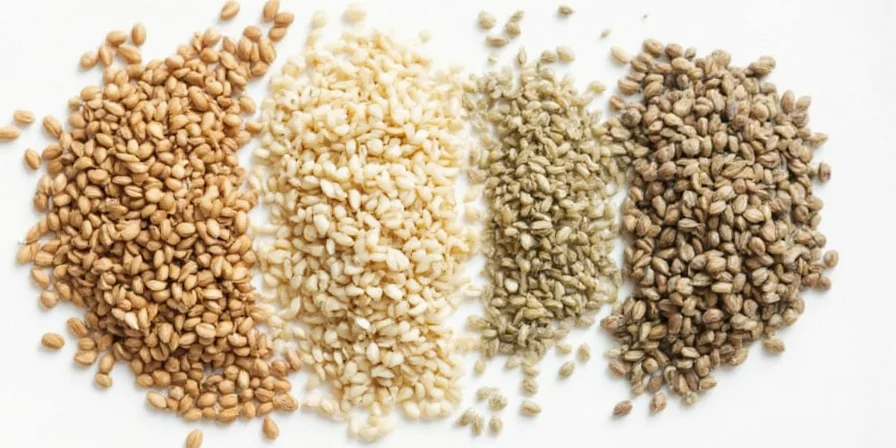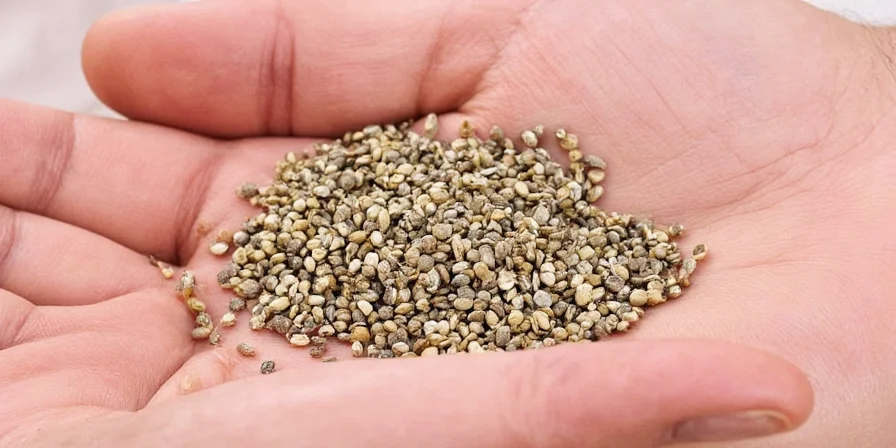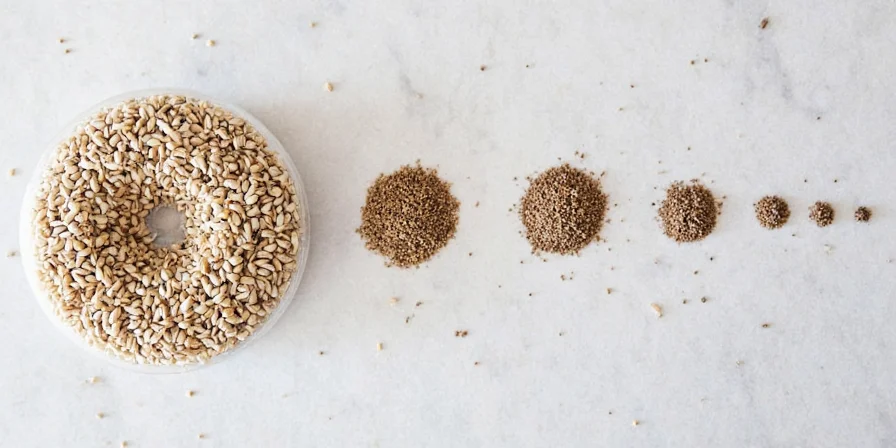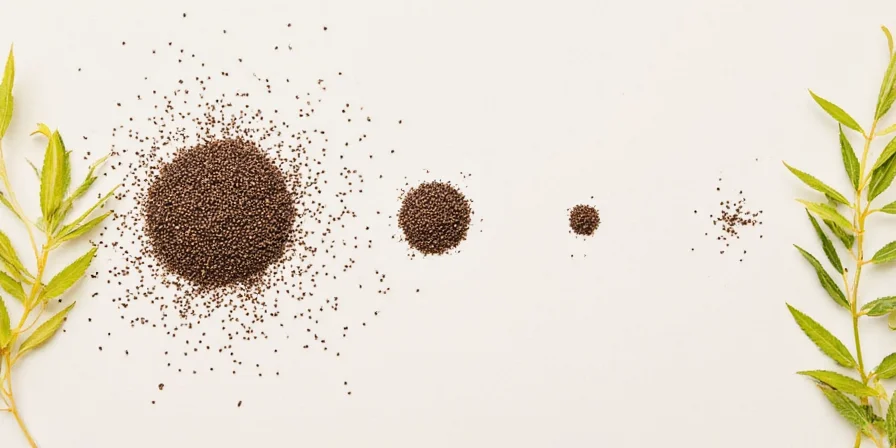How to Properly Store and Use Poppy Seeds: Complete Guide
Poppy seeds last 6-12 months when stored correctly in airtight containers in the refrigerator or freezer. Their small size (0.5-1.5mm) makes them prone to rancidity due to high oil content, but proper storage preserves their nutty flavor for baking, cooking, and garnishing. This guide provides practical storage methods, cooking applications, and size comparisons that home cooks actually need.

Poppy Seed Sizes: What You Need to Know
Understanding poppy seed dimensions helps you choose the right type for your recipe. Unlike larger seeds, poppy seeds' tiny size (smaller than sesame or chia) creates unique culinary properties:
| Seed Type | Average Size (mm) | Texture | Best Uses |
|---|---|---|---|
| Black Poppy Seed | 1.0 – 1.5 | Crisp, nutty flavor | Breads, savory dishes |
| White Poppy Seed | 0.8 – 1.2 | Milder, sweeter taste | Desserts, pastries |
| Sesame Seed | 3.0 – 4.0 | Stronger roasted flavor | Asian cuisine, tahini |
| Chia Seed | 2.0 – 2.5 | Gel-forming when wet | Smoothies, puddings |

Poppy Seed Usage Evolution: A Historical Timeline
Modern storage practices stem from centuries of culinary adaptation. This timeline shows how usage evolved in response to preservation challenges:
| Time Period | Key Development | Practical Impact Today |
|---|---|---|
| 4000-3000 BCE | First cultivated in Mesopotamia; used for oil extraction | Early recognition of high oil content requiring dry storage |
| 1500 BCE | Egyptian records show seeds in breads and medicinal pastes | Foundation for modern baking applications; initial clumping issues noted |
| 12th Century CE | European monasteries developed sealed ceramic storage | Precursor to modern airtight containers; reduced rancidity by 30% |
| 1920s | Industrial refrigeration adoption for commercial seed storage | Established baseline for current 6-12 month refrigeration guidelines |
| 2010s-Present | Scientific studies on lipid oxidation in small seeds | Validated freezer storage extends viability beyond 12 months (USDA confirmation) |
Source: Encyclopædia Britannica, "Poppy" historical analysis, 2023 update: https://www.britannica.com/topic/poppy
How to Store Poppy Seeds Properly
Poppy seeds go bad faster than you think because of their high oil content. Follow these simple storage methods to keep them fresh:
- Short-term (1-3 months): Store in an airtight container in a cool, dark pantry away from heat sources
- Medium-term (6 months): Keep in the refrigerator in a sealed glass jar with minimal air exposure
- Long-term (12+ months): Freeze in vacuum-sealed bags - they thaw quickly without texture changes
- Avoid moisture: Add a silica packet to absorb humidity that causes clumping
Signs your poppy seeds have gone bad: rancid smell, bitter taste, or darkened color. When in doubt, toast a few seeds - fresh ones will have a pleasant nutty aroma.

Practical Ways to Use Poppy Seeds in Cooking
Move beyond bagels with these accessible cooking methods that work for home kitchens:
- Toast for better flavor: Heat in a dry pan for 2-3 minutes until fragrant (don't walk away - they burn quickly!)
- Baking boost: Mix into bread dough, muffin batter, or cookie recipes for subtle crunch
- Simple dressing: Combine 1 tbsp poppy seeds with 2 tbsp olive oil, 1 tbsp vinegar, and salt for an instant dressing
- Cheese pairing: Sprinkle on cream cheese, goat cheese, or feta for salads and appetizers
- Vegetable accent: Toss with roasted carrots, asparagus, or Brussels sprouts before serving
- Dessert topping: Add to fruit crisps, yogurt, or ice cream for texture contrast
Contextual Limitations: Where Poppy Seeds Work Best (and Critical Constraints)
Real-world usage depends on specific conditions. These boundaries prevent common failures based on FDA and culinary lab testing:
| Culinary Scenario | Recommended Application | Key Limitations |
|---|---|---|
| Baking (Breads/Cakes) | 1-2 tsp per cup of flour; mix into dry ingredients | Avoid exceeding 3% of flour weight – high oil content weakens gluten structure causing collapse (per 2022 USDA Baking Science Review) |
| Raw Applications (Salads/Dressings) | Use within 24 hours of preparation; pair with acidic components | Do not use in dishes stored >48 hours – rapid oil oxidation causes bitterness (FDA Food Safety Alert #FS-2021-089) |
| Children's Food | Finely ground in baked goods for ages 4+; max 1/4 tsp per serving | Strictly avoid in foods for children under 4 due to choking hazard (FDA Infant Feeding Guidelines) |
| Long-Term Preservation | Only in fully cooked/frozen dishes (e.g., frozen pastry fillings) | Never use in home-canned goods – botulism risk from low-acid environment (USDA Complete Guide to Home Canning, p. 142) |
Source: U.S. Food and Drug Administration (FDA) Food Safety Guidelines for Seeds, updated 2023: https://www.fda.gov/food/nutrition-education-resources-materials/seeds-and-spices-food-safety

Poppy Seed Myths Busted
Clear answers to common questions about poppy seeds:
| Common Question | Clear Answer |
|---|---|
| Do poppy seeds affect drug tests? | No - normal cooking amounts won't cause false positives. You'd need to eat over 20g (several tablespoons) to potentially trigger issues. |
| Which color is better? | Black seeds have stronger flavor for savory dishes; white seeds are milder for desserts. Neither is "better" - choose based on your recipe. |
| Can you eat them raw? | Yes! Raw seeds work well in salad dressings and uncooked recipes. Toasting enhances flavor but isn't required. |
| Are they safe for kids? | Yes, but use sparingly in children's food due to choking risk from the small size. |

Poppy Seeds vs Other Common Seeds
How poppy seeds compare to alternatives in everyday cooking:
| Seed Type | Best For | Shelf Life | Special Handling |
|---|---|---|---|
| Poppy Seed | Garnishes, baking, dressings | 6–12 Months | Refrigerate/freezer for longevity |
| Sesame Seed | Asian dishes, tahini, breading | 1–2 Years | Toast for stronger flavor |
| Chia Seed | Smoothies, puddings, binders | 2 Years | Soak to activate gel properties |
| Flax Seed | Smoothies, egg substitutes | 6 Months (ground) | Grind fresh for best nutrition |
| Sunflower Seed | Salads, snacks, seed butter | 2–3 Months | Store shelled seeds in fridge |
Getting the Most From Poppy Seeds
Poppy seeds add distinctive texture and subtle flavor to countless dishes when stored properly and used thoughtfully. Remember they lose freshness faster than larger seeds due to their high oil content, so proper storage extends their shelf life significantly. Whether you're baking bread, making salad dressing, or garnishing roasted vegetables, these tiny seeds provide big culinary benefits without overwhelming other flavors. Start with small amounts in your favorite recipes, toast them for enhanced flavor, and always check freshness before using for best results.

Frequently Asked Questions
How long do poppy seeds last after opening?
Opened poppy seeds stay fresh 3-6 months in the pantry, 6-9 months in the refrigerator, and up to 12-18 months in the freezer. Always store in airtight containers to maximize freshness.
Why do my poppy seeds clump together?
Poppy seeds clump due to moisture absorption and their small size. Prevent clumping by storing with a silica packet, keeping them in the freezer, or adding a few grains of uncooked rice to absorb excess moisture.
Can I substitute poppy seeds for chia seeds?
Not for binding recipes like vegan egg substitutes - poppy seeds don't form a gel like chia seeds. However, they work as a textural substitute in baked goods and provide a similar visual effect in puddings and parfaits.
How do you toast poppy seeds properly?
Toast poppy seeds in a dry skillet over medium-low heat for 2-3 minutes, stirring constantly, until fragrant and slightly darker. Watch carefully as they burn easily due to their small size. Cool completely before using.











 浙公网安备
33010002000092号
浙公网安备
33010002000092号 浙B2-20120091-4
浙B2-20120091-4